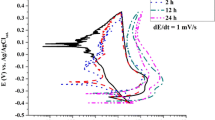Abstract
Electrochemical impedance spectroscopy (EIS), anodic polarization and scanning electron microscopy techniques were used to investigate the damage mechanism in the transpassive potential region of AISI 316 and AISI 316L solution-annealed stainless steels (SS) with different degrees of sensitization. Depending on the DC potential applied during EIS tests, the AC responses in the transpassive region included three different regions: the first one associated with anodic dissolution of the passive layer, the second one contributed to the dissolution at the area near grain boundaries, and the last one attributed to pitting corrosion. In addition, the fitting results to experimental data showed that as the DC bias during the EIS test increases the charge transfer resistance (R ct) decreases. Moreover, the R ct values decreased as the sensitization temperature increases but the AISI 316L SS samples exhibited a higher resistance to intergranular corrosion than 316 SS samples.
Similar content being viewed by others
References
G.H. Aydoğdu and M.K. Aydinol, Determination of susceptibility to intergranular corrosion and electrochemical reactivation behaviour of AISI 316L type stainless steel, Corros. Sci., 48(2006), No. 11, p. 3565.
American Society for Testing and Materials, ASTM G108 Standard Test Method for Electrochemical Reactivation (EPR) for Detecting Sensitization of AISI Type 304 and 304L Stainless Steels, 2010.
S. Rahimi, D. L. Engelberg, and T. J. Marrow, A new approach for DL-EPR testing of thermo-mechanically processed austenitic stainless steel, Corros. Sci., 53(2011), No. 12, p. 4213.
A. Arutunow and K. Darowicki, DEIS evaluation of the relative effective surface area of AISI 304 stainless steel dissolution process in conditions of intergranular corrosion, Electrochim. Acta, 54(2009), No. 3, p. 1034.
A. Arutunow, K. Darowicki, and A. Zieliński, Atomic force microscopy based approach to local impedance measurements of grain interiors and grain boundaries of sensitized AISI 304 stainless steel, Electrochim. Acta, 56(2011), No. 5, p. 2372.
S. Chen, H. Huang, C. Liu, and Y. Pan, Technique for detecting sensitization in austenitic stainless steel, Corrosion, 48(1992), No. 7, p. 594.
Y.L. Huang, H. Shih, H.C. Huang, J. Daugherty, S. Wu, S. Ramanathan, C. Chang, and F. Mansfeld, Evaluation of the corrosion resistance of anodized aluminum 6061 using electrochemical impedance spectroscopy (EIS), Corros. Sci., 50(2008), No. 12, p. 3569.
A. Królikowski and J. Kuziak, Impedance study on calcium nitrite as a penetrating corrosion inhibitor for steel in concrete, Electrochim. Acta, 56(2011), No. 23, p. 7845.
Z. Sharer and J. Sykes, Insights into protection mechanisms of organic coatings from thermal testing with EIS, Prog. Org. Coat., 74(2012), No. 2, p. 405.
R. Natarajan, N. Palaniswamy, M. Natesan, and V.S. Muralidharan, XPS analysis of passive film on stainless steel, Open Corros. J., 2(2009), p. 114.
A. Fattah-Alhosseini, M. Mosavi, and A. Allahdadi, An electrochemical impedance study of AISI 321 stainless steel in 0.5 M H2SO4, Int. J. Electrochem., 2011, art. No. 505929.
A. Fattah-Alhosseini, S.T. Shoja, B.H. Zebardast, and P.M. Samim, An electrochemical impedance spectroscopic study of the passive state on AISI 304 stainless steel, Int. J. Electrochem., 2011, art. No. 152143.
C.A. Huang, Y.Z. Chang, and S.C. Chen, The electrochemical behavior of austenitic stainless steel with different degrees of sensitization in the transpassive potential region in 1 M H2SO4 containing chloride, Corros. Sci., 46(2004), No. 6, p. 1501.
J.L. Polo, E. Cano, and J.M. Bastidas, An impedance study on the influence of molybdenum in stainless steel, J. Electroanal. Chem., 537(2002), No. 1–2, p. 183.
Author information
Authors and Affiliations
Corresponding author
Rights and permissions
About this article
Cite this article
Morshed Behbahani, K., Pakshir, M., Abbasi, Z. et al. Damage mechanism at different transpassive potentials of solution-annealed 316 and 316l stainless steels. Int J Miner Metall Mater 22, 45–51 (2015). https://doi.org/10.1007/s12613-015-1042-x
Received:
Revised:
Accepted:
Published:
Issue Date:
DOI: https://doi.org/10.1007/s12613-015-1042-x




